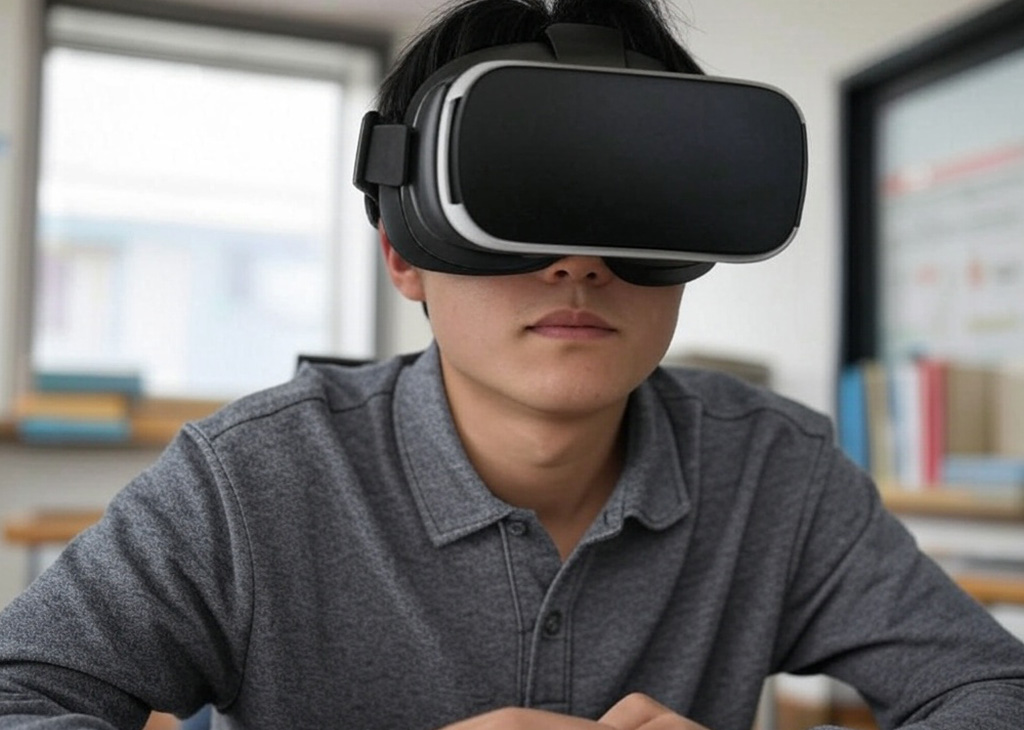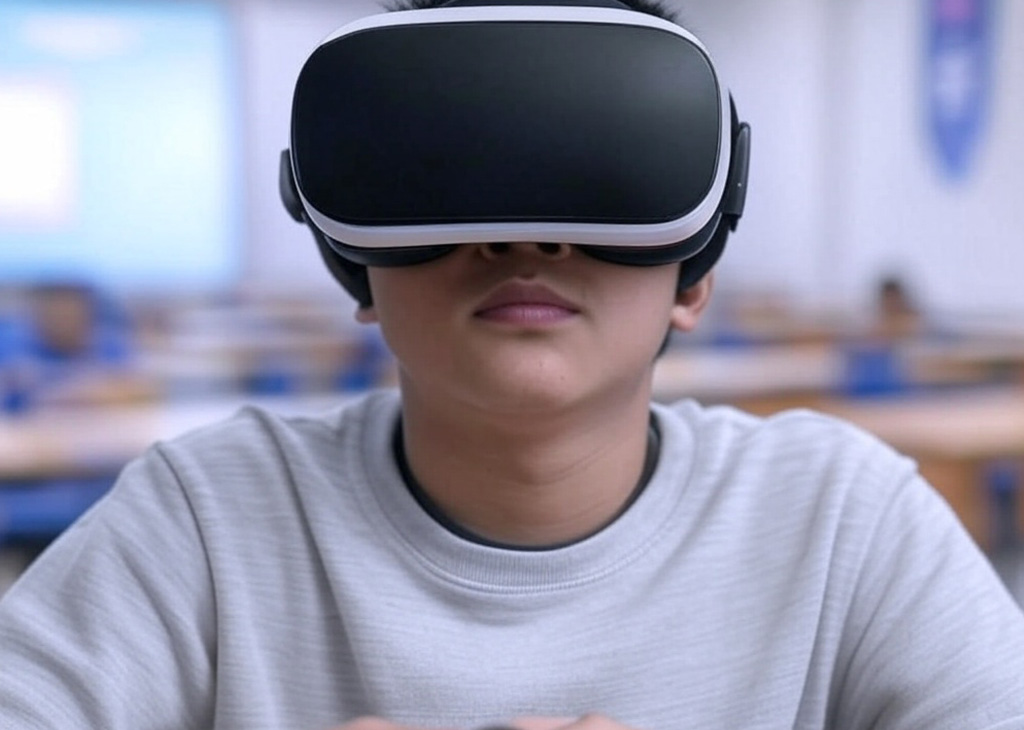Immersive Learning | Virtual Space, Real World Solutions
An Arctic Classroom
Now imagine you're in Ohio, a middle-school student who puts on VR goggles in science class. You're not sitting at a desk anymore, and suddenly you're standing on a collapsing Arctic ice sheet, the wind howling as chunks of it dissolve into the ocean. You can almost freeze when muggy hawsers on the up styled surge a hundred miles from your live tent place. Then the teacher's voice breaks in: But what if this was your hometown going under didn't stand a chance what would you do? This isn't some Hollywood movie this is immersive, experiential learning that is taking teachers and students in North America by storm by early 2025.

Virtual reality (VR) and augmented reality (AR) technologies have had their shine over the last several years and have grown beyond a shiny new toy they're serious tools in some U.S. classrooms. By the end of 2024 one more gear had appeared on the sled run Meta had released an affordable Quest 4, Apple for the masses at prices to which the stuff of cost detente had not yet remotely arrived, while the shanties of Apple's Vision Pro AR glasses sold at prices that divided cost detente in two. The latest report by EdTech Innovate states that one-third of U.S. public schools had signed on to get on board with immersive learning by March 2025. And it's not even about dazzling kids with tech it's about giving them climate crises, inequality and real-world mega problems to wrangle with. So let's unpack this game changer both literally and figuratively walk through what it's doing to students, and examine whether it's really producing problem-solvers or just VR junkies.
What Is Immersive Learning, and Why Is It Huge at the Moment?
Immersive learning places kids on virtual sets, so they don't merely read about stuff they get to experience it. With V.R., they could be sent in the maw of a hurricane to design a rescue; with A.R., they could see a figure of the Civil War rendered in their classroom for a Q. and A. It's about tasting behind hearing. But why is it blowing up (in) 2024–2025? Three big reasons:
Tech Has Never Been Cheaper Taking $299 out of your pocket for a video game headset (the price of the Quest 4, per The Wall Street Journal (November 2024) comparing it for $100 less than its predecessor. Now cash-strapped schools can hit the field.
Problems for Real Life: Climate chaos and inequality aren't just something out of a hypothetical textbook they appear on the nightly news. And they can feel it, and they want to be able to rise up.

More Parents Want: Sixty-seven percent of parents who responded to a survey conducted by the National Education Association (NEA) in spring 2024 said they wanted lessons that taught kids how do (real) things rather than rote memorization of facts they would not use immediately.
UC Berkeley's education wise woman Linda Darling-Hammond nailed it last week on NPR: Kids are swimming in info these days they don't need you to pour facts into, they need a mechanism to convert knowing to doing. Immersive learning isn't about the bells and whistles it's a mind-set reboot.
Case Study #1: When the Kids Are Burning, Ice the Thaw
First let's focus here at home in Michigan, where a middle school worked alongside the Climate Reality Project on an interactive VR classroom program called Glacier Crisis (New York Times, December 2024). Eight graders belt on headsets and slam an melting ice shelf cracks creak seals flop burn data: X feet of sea level creep for 2 degrees C rise. Their mission? Play the mayor and keep a dead-nettle state afloat.
Dr Sarah James, a researcher at MSU who studied 120 of these children. Afterwards, 85 percent said they care more about climate change; 73 percent had ideas electric buses, less plastic as mini activists. VR turned ‘I know' into ‘I need to fix this,' James wrote. I used to think climate stuff was years off, then standing there I imagined my lakefront street underwater. It really scared me I want to do something. That jolt from the virtual to the human? That's the inspiration sparked by immersive learning.
Case Study #2: The Local as the Site of Inequity
It's not only nature social issues are given the immersive treatment as well. Apparently because of a New York City high school that was sponging away its Street View AR project found by PBS in January 2025, erasing AR dirt on sidewalks and depositing wealth marksbased on the great gaping divide of the economy (Pew Research, 2024: top 1% owns 40% of the dough, bottom 50% subsists on 2.5%). AR glasses out, leaving the glimmering towers of Manhattan behind and heading into the gritty streets of the Bronx. A voice over (A median income here?) morality, belches statistics: here median income? College access there? They talk to digital residents a single mother holding down double shifts, say and sense the squeeze.
Numbers don't resonate, a teacher there, Matthew Gonzalez, told PBS in an interview. The post-class outcome: Sixty percent of these youngsters committed themselves whole hog to volunteerism, rallying the gear collection for the homeless. Jamal, who is 16, said, I used to just be like poor people don't try. Seeing the way they work ⎯ it's not like you just come here you do it, just like that. This reef of wailing and gnashing of teeth from meh to whoa encourages empathy and critical thought two emotions that rarely carry a market price in textbooks.
The Proof: Numbers That Pop
Stories are an efficient way to learn, but let's do some numbers now. Then in fall 2024, the American Educational Research Association (AERA) questioned 5,000 U.S. students and threw immersive learning head-to-head with old-school methods:
Immersive Virtual Reality and Augmented Reality learners outperformed traditional conditions by 15 percent on retention tests
Problem-Solving Muscle: 68 percent produced helpful solutions in simulations vs. 42 percent in regular classes.
Beyond-the-Classroom Vision: 57% faltered on social issues, versus 29% on chalk-and- talk decorum.
So what findings did Harvard's Education School (early 2025) report in its own 8-week pilot, letting VR kids solve ecol-puzzles, how they outsmarted their lecture-only peers 22% on critical thinking points? Why? Immersion means that you must ask questions, argue and make decisions, not just slobber over notes.
FINDING YOUR HEART, LET THE GOGGLES GO
VR addiction isn't the endgame it's just getting kids to do a thing. No scratch paper here they started a Green Campus campaign, managing to cut school paper use and raising $5,000 for rainforest funds (Ohio high schooled simulated to Amazon rainforest loss, The Washington Post (Q4 2024). If we don't, those trees are do does! Teacher Kate Moore beamed. They were pleading with me to do something. They even retired to take their cause to local lawmakers for stricter eco rules.
Fairly early I noticed The Los Angeles Times (February 2025) issuing questions about a backpacking session where community college kids experienced homelessness through AR. Soon enough they're hauling winter supplies for the unhorsed. That AR sleeping on the street, that was a gut punch I couldn't unseen it, said Sophia Chen, lead. Not lessons, but launchpads for kids who don't just know they do.
The Catch: It's Not All Roses
Immersive learning has the shine and the shadows. V.R. is also costly 20 percent of schools in the U.S. can't afford to maintain V.R., with the Department of Education (2024) reporting that the number of free versions of schools is vanishing. Young people who become dangerously addicted to the type of instant-gratification influenced by virtual reality will find it nearly impossible to relinquish that when disaster strikes in real life, Alan Burke, a psychologist, wrote in Frontiers in Educational Psychology (Jan. 2025). It'll take more than a little sim fix to satisfy the red tape of the real world. And privacy is, like, a total buzzkill AR can track your blinks and who you want to kiss, and a 2024 Verge scoop landed an ed-tech company a $500,000 fine for data biopsies. That is why tech is sweet but it should be smart.
The Big Idea Where Tomorrow's Doers Start
Immersive learning is a starting point; there is no finish line. It introduces kids to climate chaos and inequality, puts their neurons in solve it mode then enlists them to do something. Emily's "what if my street floods? moment nails it: I'm not simply hanging around I'm changing shit.
There are big changes coming to North America's classrooms in late 2024 and early 2025. VR and AR bring distant issues into the present; they transform people from passive consumers of information into actively engaged solutions providers. The next Eco-warrior or equity champ is perhaps strapping on a headset and getting their simulation on as we speak. Thomas Friedman had the right idea in New York Times in 2025: It's not really about filling heads it's about lighting fires. When those glasses go on, kids don't just see problems they see themselves solving them. What do you make of it genius or gimmick?
